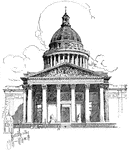Clipart tagged: ‘pantheon’
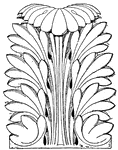
Roman Leaf
The Roman Leaf design is shown as a capital of a column in Pantheon, Rome. The spoon-like roundings…

Pantheon
"The finest monument of this time is the Pantheon of Rome, first built about B.C. 27, which is one of…
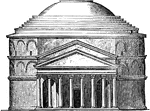
Façade of the Pantheon at Rome
"The most important and most beautiful of circular buildings without columns surrounding it is the Pantheon…
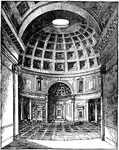
Interior of the Pantheon at Rome
"The most important and most beautiful of circular buildings without columns surrounding it is the Pantheon…
![The Panthéon (Latin Pantheon, from Greek Pantheon, meaning "Every god") is a building in the Latin Quarter in Paris, France. It was originally built as a church dedicated to St. Genevieve, but after many changes now combines liturgical functions with its role as a famous burial place. It is an early example of Neoclassicism, with a façade modeled on the Pantheon in Rome, surmounted by a small dome that owes some of its character to Bramante's "Tempietto". Located in the 5th arrondissement on the Montagne Sainte-Geneviève, the Panthéon looks out over all of Paris. Its architect, Jacques-Germain Soufflot, had the intention of combining the lightness and brightness of the gothic cathedral with classical principles. Soufflot died before his work was achieved, and his plans were not entirely followed. The transparency he had planned for his masterpiece was not attained. Nevertheless, it is one of the most important architectural achievements of its time and the first great neoclassical monument."Toward the end of the reign of Louis XV. a reaction set in, which was caused partly by the excess and caprice displayed in the application of this style, and partly by the tide again setting in the direction of the antique. This evidence by the Colonnades de la Place de Concorde, and by the Church of Ste. Geneviève, which was begun by Soufflot in the year 1755, and subsequently received the name of Pantheon [shown here]. From thenceforth imitations of ancient buildings came into vogue, as they also did in other countries."](https://etc.usf.edu/clipart/73700/73751/73751_pantheon_mth.gif)
West Front of the Pantheon at Paris
The Panthéon (Latin Pantheon, from Greek Pantheon, meaning "Every god") is a building in the Latin…
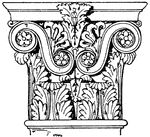
Roman-Corinthian Pilaster Capital
The Roman-Corinthian pilaster capital has a leaf and floral design, then it volutes with a spiral scroll…

The Pantheon at Rome
The pantheon at Rome is a temple that was built to all the gods of Ancient Rome. It was built by Marcus…
